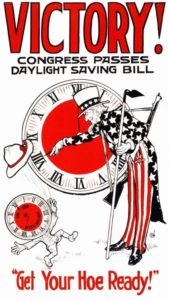On January 16, 1917 the Kinsley Mercury ran an article which began:
“To Launch Plans to Save Daylight
National Convention in New York This Month—Railroads Are Ready to Fall in Line with the Plan to Set Clocks Up May 1.
A movement is on foot to turn the clock forward one hour in every community in the United states next summer, and so obtain one more hour of daylight for everyone….”
It didn’t happen that summer, but in 1918 Daylight Saving Time was adopted by the Federal Fuel Administration. In their effort to conserve energy during the war, the United States would follow Germany and Europe’s lead and established Daylight Saving Time (DST). It was not a new idea in America. In fact,
Ben Franklin first wrote about it during the country’s early days as a way to save money on candle wax. However it was the passage of the Standard Time Act of 1918 which established both standard time zones and set summer DST to begin on March 19, 1918.
Though the rationale was to save fuel, the U.S. Chamber of Commerce backed the plan because when people get off work and it is still light, they are apt to go shopping in the evening. Sports and recreational activities also profited. Baseball fields were not artificially lit, and this allowed for more time in the evening to play games. Golf also had a boost as people could hit the links after work in the daylight.
But many others did not like the idea. Some warned it was “taking us off God’s time”. Movie theaters were affected in that people did not want to go into a dark theater when it was still light outside. But the farmers protested the most as they had less time in the morning to get their milk and harvested crop s to market.
Those against Daylight Saving Time won the argument when Congress did away with it by overriding President Woodrow Wilson’s veto that October, even before the Versailles Treaty was signed. DST became a local option and was observed in some states until World War II, when President Franklin Roosevelt instituted year-round DST, called “War Time,” on February 9, 1942 for everyone. That lasted until the last Sunday in September 1945. The next year, many states and localities adopted summer DST. But time remained confusing with different cities and states choosing and not choosing to adopt it. President Lyndon B. Johnson signed the first peacetime Daylight Saving Time law which forced states to opt in or opt out. In 1973, again worried about fuel during the oil embargo, President Richard M. Nixon called for year-round Daylight Saving Time. It was unsuccessful partly because of the danger of children going to school in the dark. Today with the exception of Arizona, Hawaii, Puerto Rico, the Virgin Islands, American Samoa, Guam and the Northern Mariana Island, the states observe eight months of Daylight Saving Time.

